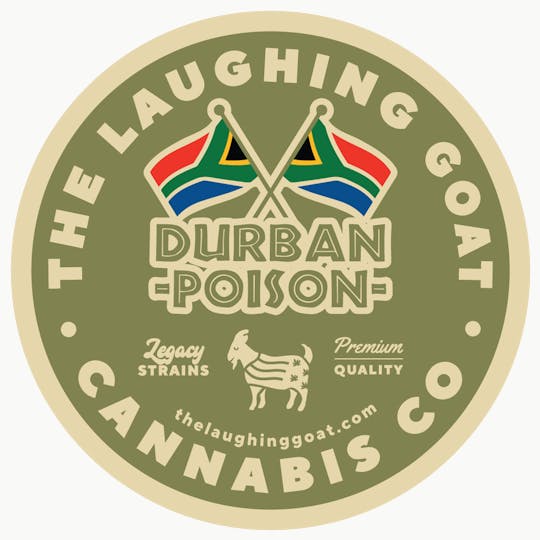
DURBAN POISON | SMALL BUDS
[ THE LAUGHING G.O.A.T. LEGACY STRAIN ]
Durban Poison has gained popularity worldwide for its sweet smell and energetic, uplifting effects. Durban Poison is the perfect strain to help you stay productive through a busy day, when exploring the outdoors, or to lend a spark of creativity. We are proud to offer this exotic and legendary strain and love the clean, energetic and focused high.
THC: 21.9% – 25.40%
TOTAL CANNABINOIDS: 25.80% – 30.80%
TOTAL TERPENES: 3.28% – 5%
[ SATIVA-DOMINANT HYBRID ]
[ LINEAGE ]
South African Landrace
[ ANTICIPATED EFFECTS ]
Uplifting, Focused, Happy
[ PRIMARY TERPENES ]
Terpinolene
β-Myrcene
Trans-Ocimene
Limonene
β-Caryophyllene
β-Pinene
Guaiol
[ FLAVOR ]
Spicy
Sweet
Vanilla
Cream
Tea
Fennel
[ AROMA ]
Dank
Licorice
Pine
Herbal
Sage
- Earthy
- Woody
- Spicy/Herbal
----------The Laughing Goat - Premium Cannabis----------
Durban Poison has deep roots in the Sativa landrace gene pool. The strain’s historic phenotypes were first noticed in the late 1970s by one of America’s first International strain hunters, Ed Rosenthal. According to cultivation legend, Rosenthal was in South Africa in search of new genetics and ran across a fast flowering strain in the port city of Durban. After arriving home in the U.S., Rosenthal conducted his own selective breeding process on his recently imported seeds, then begin sharing. Rosenthal gave Mel Frank some of his new South African seeds, and the rest was cannabis history.
Frank, who wrote the “Marijuana Grower’s Guide Deluxe" in 1978, modified the gene pool to increase resin content and decrease the flowering time. In search of a short-season varietal that could hit full maturation on the U.S. East Coast, Frank’s crossbreeding efforts resulted in two distinct phenotypes, the “A” line and “B” line. The plant from Frank’s “A” line became today’s Durban Poison, while the “B” line was handed off to Amsterdam breeder David Watson, also known as “Sam the Skunkman.”
Durban Poison has a dense, compact bud structure that’s typical of landrace Indica varieties, but the flowers’ elongated and conical shape is more characteristic of a Sativa.

